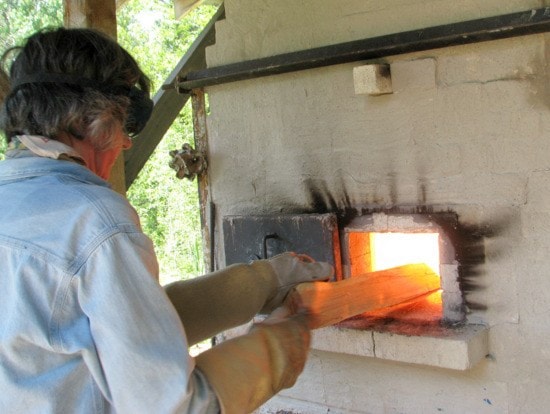Gunda Stewart has been firing her pottery the hard way since 2004 when she, with the help of husband, Wayne, built a large brick kiln in a lean-to behind her studio.
Last week, Wayne started a small fire at 6 a.m. in a seven-foot-high kiln that replaced the original two years ago. By mid-afternoon the kiln, which Stewart had carefully loaded earlier in the week, was registering more than 1,222 C (2,231.6 F), the temperature at which cone 6 bends. Throughout the process, she was pushing wood through a small opening into the firebox at a rate of a half-dozen pieces every five minutes or so. For 15 hours, the fire has to be closely tended.
Since constructing her first wood-fired kiln nearly eight years ago, Stewart has fallen in love with the process, which she describes as “expensive and labour intensive”. It costs about $300 per firing for the wood, grinding wheels (for kiln shelves and posts) and grates, which are replaced every five or six firings. The wood also has to be split; for the most part, that’s Wayne’s job.
An accomplished potter long before she took to wood firing, Stewart describes her work as functional, with influences from English, German and Japanese folk pottery. And in the last year or so, she’s made another dramatic change, selling nearly all of her work locally, instead of galleries around the country, “which always demand my best pieces.”
“Strictly being a local potter, I’m loving it,” she smiles. “To be in a small community and to know your customers is very special. Local people are such great supporters.”
Stewart admits to hedging a bit on the local angle — she’s finding it hard to say no to orders from Toronto’s prestigious Gardiner Museum gallery, one of the best sites in Canada for a potter’s work to be shown. But her focus is on the local market.
Throughout the conversation, Stewart keeps a close eye on peepholes in the kiln and an ear on the sound, which quiets when the flames begin to die down. She is aiming for a 1,300 C peak temperature, but will work to hold it at slightly lower temperatures for “soak” periods. Inside, the heat is hardening the clay bowls, plates, mugs and other containers, melting the special glazes and decorating them with tiny marks from wood ash that flies around in the high temperatures.
“It’s a fine balance between air and fuel,” she says. “Too much fuel and the kiln atmosphere changes to a dark, smoky one, which causes the black glazes to run.”
Subtlety and wood firing go together like Stewart and her kick-propelled potter’s wheel in the studio.
Wood firing and a kick wheel? Hasn’t she heard about electricity? Sure, but she prefers the silence of the kick wheel and the endless variations that the wood kiln puts onto the surface of her pots.
“I enjoy the physicality of the work, too, both inside the studio and out here at the kiln.”
She and Wayne got plenty of physical work in when they constructed the first kiln from tons of bricks in 2004.
“It should have lasted 20 years, but we got bad bricks.”
The aging of that kiln was also sped up by the salt-firing process she was using, throwing handfuls of salt into the flames to create unique and hard to control surfaces on the pieces inside. That first kiln lasted five years, then the couple rolled up their sleeves and set to work on a new one, with a slightly different design.
At seven feet tall and nearly eight feet in length, the kiln is no small thing. Photos on her blog (gundastewart.blogspot.ca) show her crouched inside the firing area, carefully stacking a variety of pots to eventually fill the space. When the load is ready, she stacks bricks to close in the opening, then seals it up with a mix of newspapers and clay slurry. The kiln is designed with a number of small openings that are controlled by moving loose bricks in and out to control the movement of air during the firing. Wood is burned in the kiln’s firebox with pieces fed in through a door closer to eye level. Stewart wears heavy Kevlar gloves and a face shield to protect herself from the intense heat that greets her each time she fuels the fire.
So what motivated her to set aside her electric kiln and begin firing her creations with wood?
“You get tiny ash speckles in the glazes and marks on the clay from the flames, which I think is very cool,” she says. “Colours are unpredictable — not uncontrolled and random or serendipitous, but not the same each time. I know that certain things will happen in the kiln — usually. But the results are always slightly different, even from one spot in the kiln to another.”
The unpredictability also pops up during the firing. Her eyes open wide as she interrupts the conversation to check an external pyrometer, a second way to monitor the temperature (the first being cones inside, that slump at specific temperatures). The pyrometer temperature has dropped to 900 C. She adds wood to the fire and it jumps to 1,100, then suddenly dips to 600.
Wayne comes to the rescue, playing with the wires that run to sensors inside the kiln. They have become corroded and with a little cleaning the device’s accuracy is restored.
She relaxes and is soon back into a rhythm of feeding the fire and standing back to cool off.
“I love fire. I’m good at fire. I enjoy the process. And I like being out here. I like the peacefulness.”
